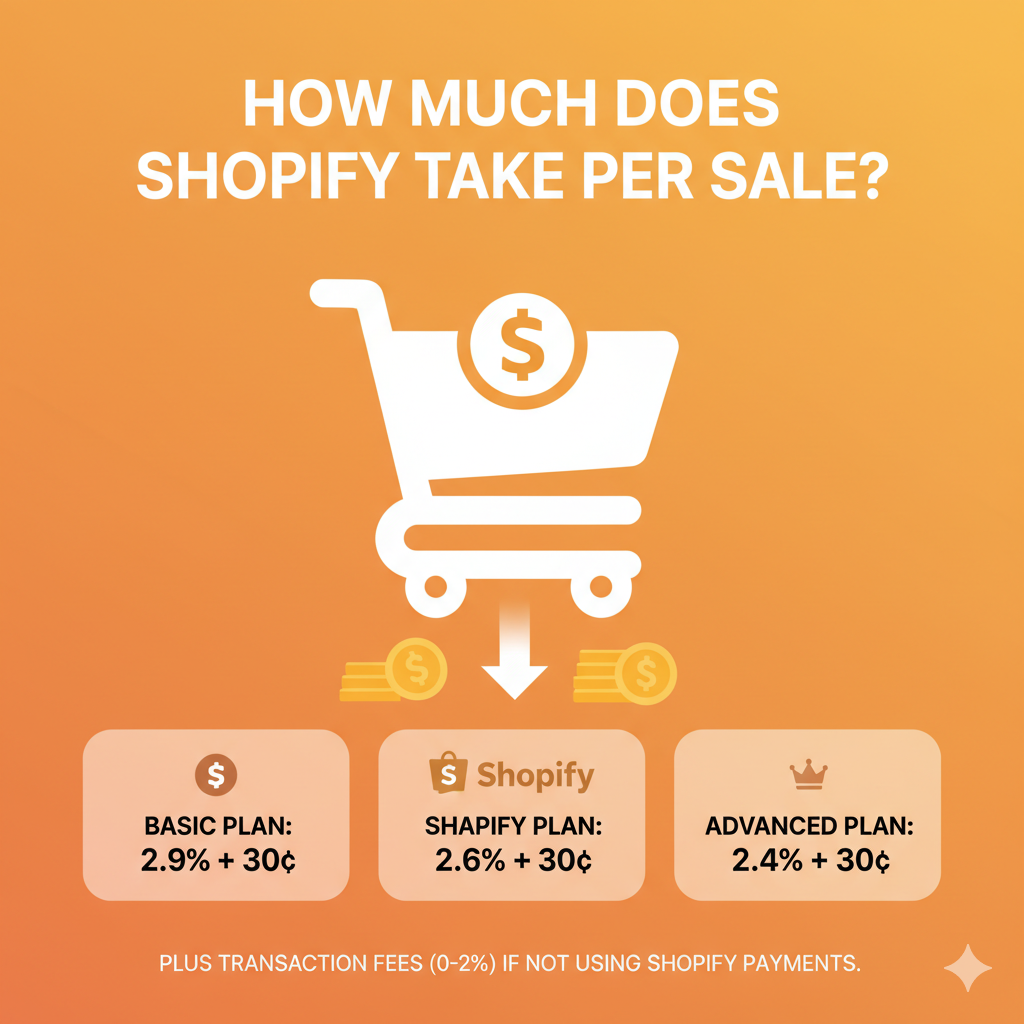If you’re planning to start an online store on Shopify, one of the first things that probably comes to mind is how much does Shopify actually take per sale? It’s a valid question because knowing your costs upfront helps you price your products smartly and manage profits better.
Let’s break down everything you need to know from Shopify fees to transaction costs and ways to save money on them.
Shopify’s Pricing Plans
Shopify doesn’t take a fixed percentage from every sale by default. Instead, it charges a monthly subscription fee, and transaction fees depending on your plan and payment method.
Here’s a quick overview of Shopify’s core pricing plans (as of 2025):
| Shopify Plan | Monthly Price | Transaction Fee (if not using Shopify Payments) |
|---|---|---|
| Basic | $39/month | 2.0% |
| Shopify (Standard) | $105/month | 1.0% |
| Advanced | $399/month | 0.5% |
💡 Shopify also offers a “Starter” plan ($5/month) for selling via social media or messaging apps, but it has limited features.
Shopify Transaction Fees Explained
When you make a sale, Shopify may charge a transaction fee, depending on how you accept payments.
There are two main scenarios:
1. If You Use Shopify Payments
If you use Shopify Payments (Shopify’s own payment processor), you don’t pay extra transaction fees to Shopify. However, you’ll still pay credit card processing fees, which are standard for all payment gateways.
Here’s what you’ll pay when using Shopify Payments (for U.S. merchants):
| Plan | Online Credit Card Rate | In-person Rate |
|---|---|---|
| Basic | 2.9% + 30¢ per transaction | 2.7% |
| Shopify | 2.6% + 30¢ per transaction | 2.5% |
| Advanced | 2.4% + 30¢ per transaction | 2.4% |
So, for example —
If you sell a $100 product on the Basic plan using Shopify Payments, you’ll pay:
2.9% of $100 + 30¢ = $3.20 total.
That means you keep $96.80 from that sale.
2. If You Use a Third-Party Payment Gateway
If you don’t use Shopify Payments (say you use PayPal or Razorpay), Shopify adds its own transaction fee on top of your payment gateway’s fee.
Example on the Basic Plan:
- Shopify’s fee: 2.0%
- PayPal’s fee: around 2.9% + 30¢
So for a $100 sale, your total fees could be around $4.90, leaving you with $95.10.
That’s why many store owners prefer Shopify Payments — it keeps costs lower.
Are There Any Hidden Fees?
Not really, but there are a few other costs you should know about:
- Currency conversion fees: If you sell internationally, Shopify may charge up to 2% on currency conversions.
- App costs: Many useful apps (for SEO, email marketing, reviews, etc.) charge monthly fees.
- Shipping labels: If you buy shipping labels through Shopify, those costs are separate.
While these aren’t “per sale” charges directly, they can still affect your profit margins.
How to Reduce Shopify Fees
Here are some smart ways to keep more money from each sale:
- Use Shopify Payments – Avoids extra transaction fees.
- Upgrade your plan as you grow – Lower processing rates on higher plans can save money at scale.
- Encourage local/in-person sales – In-person card rates are usually cheaper.
- Optimize product pricing – Adjust pricing slightly to include the cost of fees.
- Monitor analytics – Track which payment methods your customers use most to optimize cost efficiency.
Quick Example: What Shopify Takes From a $100 Sale
| Plan | Payment Method | Shopify’s Cut | Your Earnings |
|---|---|---|---|
| Basic + Shopify Payments | Credit card | $3.20 | $96.80 |
| Basic + PayPal | Shopify (2%) + PayPal (2.9% + 30¢) | ~$4.90 | ~$95.10 |
| Shopify Plan + Shopify Payments | Credit card | $2.90 | $97.10 |
| Advanced Plan + Shopify Payments | Credit card | $2.70 | $97.30 |
So, on average, Shopify takes around 2–3% per sale, depending on your plan and payment method.
Conclusion
Shopify doesn’t take a single fixed percentage per sale it depends on your plan and how you accept payments.
If you’re using Shopify Payments, expect around 2.4%–2.9% + 30¢ per online transaction.
If you’re using a third-party payment provider, add another 0.5%–2% to that.
As your store grows, upgrading to a higher Shopify plan and sticking with Shopify Payments can significantly reduce fees and improve your margins.
FAQs
Yes, Shopify does take a small cut from each sale — but how much depends on your plan and the payment method you use.
If you use Shopify Payments, you’ll only pay the standard credit card processing fee (around 2.4%–2.9% + 30¢ per transaction).
If you use a third-party payment gateway like PayPal, Shopify adds an extra 0.5%–2% transaction fee on top of that.
It depends on your product price and plan.
Let’s say you sell a product for $100:
On the Basic plan using Shopify Payments, you’ll pay about $3.20 in fees, meaning you keep $96.80.
On the Shopify plan, you’ll pay around $2.90, keeping $97.10.
On the Advanced plan, you’ll pay roughly $2.70, keeping $97.30.
So, your profit per sale varies slightly depending on which Shopify plan you’re on.
Shopify charges 2.4%–2.9% + 30¢ per sale when using Shopify Payments.
If you use another payment provider, Shopify adds a transaction fee (0.5%–2%) on top of what your provider charges.
Essentially, Shopify’s cut can range anywhere from 2.4% to about 5% per sale depending on your setup.
It depends on what kind of business you’re running:
Shopify is better if you want to build your own branded online store, customize your website, and scale your business.
Etsy is better for individual creators or handmade sellers who want quick exposure on an existing marketplace.
However, Etsy charges listing fees and higher commission rates (around 6.5% per sale), while Shopify gives you more control and lower fees in the long run.
You can’t completely avoid fees, but you can reduce them significantly with a few smart moves:
Use Shopify Payments to skip extra transaction fees.
Upgrade your plan as your sales grow to get lower rates.
Sell in person (POS) where transaction fees are slightly lower.
Avoid unnecessary currency conversions or third-party apps that add extra charges.
These simple changes can help you keep more profit from every sale.


